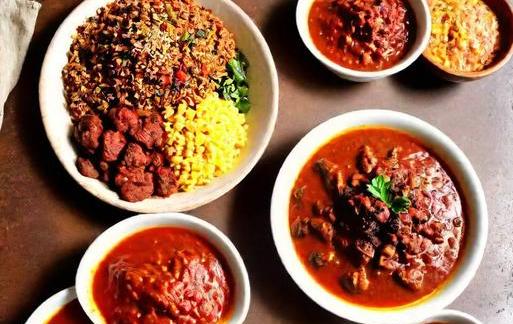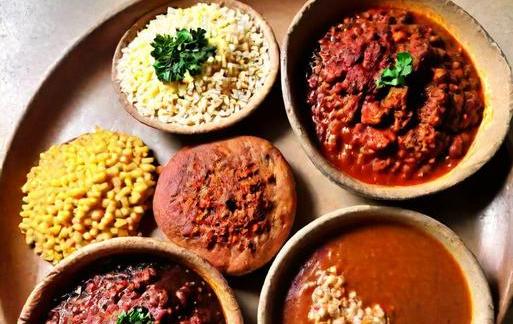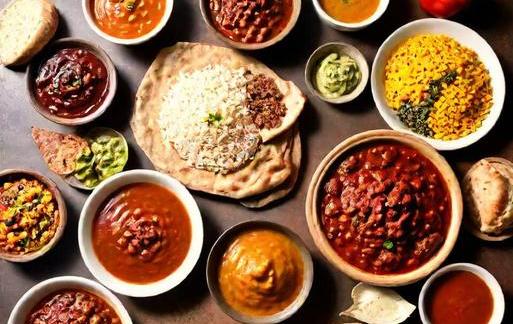- You are here:
- Home »
- Food
- » [REVEALED] African Foods That Start With K
[REVEALED] African Foods That Start With K
Note: This page contains affiliate links.
As an Amazon Associate, I earn from qualifying purchases when you click on the link, but you are not charged extra.
African cuisine is a vibrant tapestry of flavors, reflecting the diverse cultures and rich history of the continent. From savory stews to delectable desserts, each region boasts a unique culinary identity. In this article, we will explore the world of African foods that start with the letter “K”, unveiling a delightful array of dishes that showcase the continent’s culinary prowess.
Contents
- 1 List Of African Foods That Start With K
- 1.1 1. Kitfo (Ethiopia)
- 1.2 2. Kelewele (Ghana)
- 1.3 3. Koshari (Egypt)
- 1.4 4. Kapenta (Southern Africa)
- 1.5 5. Koki Beans (Cameroon)
- 1.6 6. Kuku Paka (Kenya And Tanzania)
- 1.7 7. Kenkey (Ghana And Ivory Coast)
- 1.8 8. Kachumbari (East Africa)
- 1.9 9. Klouikloui (Senegal)
- 1.10 10. Konkonte (Ghana And Ivory Coast)
- 2 Significance
- 3 Category-Related
- 4 Common Themes
- 5 Interesting Facts
- 6 Conclusion
List Of African Foods That Start With K

1. Kitfo (Ethiopia)
Description: Kitfo is a traditional Ethiopian dish that tantalizes taste buds with its bold flavors. It consists of minced raw beef, seasoned with spices such as mitmita (a chili powder blend) and niter kibbeh (clarified butter infused with herbs). The dish is often served with injera, a sourdough flatbread, making it a favorite among locals and a must-try for adventurous food enthusiasts.
Preparation: The beef is meticulously minced and mixed with the spices before being served raw or lightly cooked. The blend of spices provides a unique and unforgettable taste that sets Kitfo apart in the realm of African cuisine.
2. Kelewele (Ghana)
Description: Kelewele is a popular Ghanaian street food that delivers a spicy kick. This flavorful dish features fried plantains seasoned with a mixture of ginger, pepper, and other spices. The result is a delightful combination of sweetness and heat, creating a mouthwatering experience for those seeking a taste of Ghanaian culinary excellence.
Preparation: Plantains are cut into bite-sized pieces and marinated in a spicy blend of ginger, pepper, and other spices. The seasoned plantains are then deep-fried until golden brown, creating a crispy exterior that contrasts with the tender sweetness inside.
3. Koshari (Egypt)
Description: Koshari, also known as Kushari, is a beloved Egyptian dish that showcases the country’s diverse culinary influences. This hearty and filling meal consists of lentils, rice, pasta, chickpeas, and a tomato-based sauce. Topped with crispy fried onions, Koshari is a flavorful symphony of textures and tastes that has become a staple across Egypt.
Preparation: Each component of Koshari is cooked separately and then layered to create a visually appealing dish. The tomato sauce is generously poured over the lentils, rice, and pasta, while the crispy fried onions provide the perfect finishing touch.
4. Kapenta (Southern Africa)
Description: Kapenta, a small freshwater fish found in the lakes of Southern Africa, takes center stage in this delectable dish. Known for its rich taste and high nutritional value, Kapenta is often sun-dried before being prepared in various ways. It can be enjoyed grilled, fried, or added to stews, offering a versatile and flavorsome addition to Southern African cuisine.
Preparation: The sun-dried Kapenta is rehydrated or cooked directly, depending on the preferred method. It is then seasoned with local spices and herbs, providing a burst of flavor that complements the natural taste of the fish.
5. Koki Beans (Cameroon)
Description: Koki Beans, a traditional Cameroonian dish, showcases the country’s love for beans and aromatic spices. This savory steamed pudding is made from black-eyed peas, onions, and a blend of spices, resulting in a dense and flavorful delicacy that is often enjoyed with a side of plantains or rice.
Preparation: The black-eyed peas are soaked, ground, and mixed with finely chopped onions and spices. The mixture is then steamed in banana leaves, creating a unique texture and infusing the dish with a delightful aroma.
6. Kuku Paka (Kenya And Tanzania)
Description: Kuku Paka, also known as Chicken in Coconut Sauce, is a beloved East African dish that highlights the region’s use of coconut in savory cuisine. This aromatic and creamy chicken curry features succulent pieces of chicken cooked in a rich coconut milk sauce, seasoned with a blend of spices that create a harmonious balance of flavors.
Preparation: Chicken pieces are marinated in a spice blend, then simmered in coconut milk until tender. The resulting dish boasts a velvety texture and a perfect fusion of East African spices and coconut goodness.
7. Kenkey (Ghana And Ivory Coast)
Description: Kenkey, a staple in the cuisine of Ghana and Ivory Coast, is a fermented cornmeal dish that has become a culinary icon in West Africa. This sourdough-like delicacy is typically served with fish, soup, or a spicy pepper sauce, offering a unique taste and texture that has made it a favorite among locals.
Preparation: Maize is fermented and mixed with water to form a dough, which is then wrapped in banana leaves and steamed. The result is a dense and slightly sour product that pairs perfectly with a variety of accompaniments.
8. Kachumbari (East Africa)
Description: Kachumbari, a fresh and vibrant East African salad, adds a burst of color and flavor to any meal. This simple yet delicious dish features a combination of diced tomatoes, onions, cilantro, and chili peppers, creating a refreshing side that complements a variety of main courses.
Preparation: The ingredients are finely chopped and mixed together, with a squeeze of lime or lemon juice added for a zesty finish. Kachumbari is often served alongside grilled meats, providing a crisp and tangy contrast to the savory flavors.
9. Klouikloui (Senegal)
Description: Klouikloui, also known as Thiakry, is a Senegalese dessert that satisfies sweet cravings with its unique combination of millet, yogurt, and sugar. This delightful treat showcases the creativity of Senegalese cuisine, offering a sweet and creamy dessert that reflects the region’s culinary ingenuity.
Preparation: Millet is cooked and mixed with yogurt and sugar to create a creamy and slightly tangy dessert. Klouikloui is often garnished with coconut flakes or raisins, adding a touch of texture and sweetness.
10. Konkonte (Ghana And Ivory Coast)
Description: Konkonte, a dish originating from the Akan people of Ghana and Ivory Coast, is a hearty meal made from dried and ground cassava. This gluten-free dish, also known as abɛnkyem or ampesi, is often served with a flavorful soup or stew, making it a satisfying and nutritious choice in West African cuisine.
Preparation: Dried and ground cassava is mixed with water to form a thick, dough-like consistency. The resulting mixture is then shaped into balls or patties and boiled or steamed until fully cooked. Konkonte’s mild taste provides the perfect canvas for rich and flavorful accompaniments.
The diverse array of African foods that start with the letter ‘K’ highlights the continent’s rich culinary heritage. From savory stews to delectable desserts, each dish tells a story of tradition, creativity, and the vibrant flavors that define African cuisine. Whether it’s the bold spiciness of Kelewele from Ghana, the creamy indulgence of Kuku Paka from East Africa, or the hearty simplicity of Konkonte from West Africa, these dishes invite us to savor the unique tastes and textures that make African cuisine a true culinary treasure. So, embark on a gastronomic journey and explore the world of African foods that start with ‘K’ for a flavorful and unforgettable experience.
Significance

Africa, a continent rich in cultural diversity, is home to a myriad of culinary delights that tantalize the taste buds. Exploring the vast array of African cuisines reveals a treasure trove of unique flavors, textures, and aromas. In this gastronomic journey, we delve into the world of African foods that start with the letter "K," uncovering the culinary gems that contribute to the continent’s vibrant food culture.
Understanding the significance of African foods that start with "K" requires a glimpse into the cultural, historical, and geographical aspects of the continent. Africa’s cuisine is a reflection of its diverse landscapes, ethnicities, and traditions. The foods that fall under the letter "K" symbolize not just nourishment but also the interconnectedness of communities and the preservation of age-old culinary practices.
Category-Related

1. Kushari: A Fusion Of Flavors From Egypt
Originating from Egypt, Kushari is a delectable dish that exemplifies the harmonious fusion of various ingredients. Comprising lentils, rice, pasta, and topped with a spiced tomato sauce, Kushari showcases the diverse culinary influences that have shaped Egyptian cuisine over the centuries. The medley of textures and flavors in Kushari reflects the rich history of Egypt as a crossroads of civilizations.
2. Koki Beans: Cameroon’s Savory Steamed Pudding
In Cameroon, Koki Beans takes center stage as a beloved dish with deep cultural roots. This savory steamed pudding is crafted from black-eyed peas, onions, and spices, creating a dish that is both hearty and flavorful. The preparation of Koki Beans is often a communal affair, reinforcing the communal aspect of African cooking and the importance of shared meals in the fabric of Cameroonian society.
3. Kapenta: Zambia’s Tiny Treasures From The Water
Zambia introduces us to Kapenta, tiny dried fish that pack a powerful punch in terms of flavor and nutrition. Often used in stews and relishes, Kapenta is a testament to the resourcefulness of African communities in utilizing locally available ingredients. The preservation of fish through drying has been a traditional practice, allowing communities to enjoy the taste of the water long after the fishing season.
4. Kelewele: Ghana’s Spicy Plantain Delight
Ghana’s contribution to the list is Kelewele, a spicy street food that showcases the versatility of plantains. Sliced, spiced, and deep-fried to perfection, Kelewele is a delightful blend of sweetness and heat. Often served as a snack or side dish, this dish exemplifies how a simple ingredient can be transformed into a culinary masterpiece through skillful preparation and the use of bold spices.
5. Karoo Lamb: South Africa’s Culinary Heritage
Moving to South Africa, Karoo Lamb stands out as a culinary delight that highlights the importance of locally sourced ingredients. The vast, arid landscapes of the Karoo region provide the ideal conditions for raising lamb with a distinct flavor profile. Slow-cooked or grilled, Karoo Lamb represents a connection to the land and a celebration of South Africa’s pastoral traditions.
Common Themes
As we explore these diverse African foods that start with "K," certain common themes emerge, offering insights into the shared culinary threads that connect different regions of the continent.
1. Plant-Based Staples: A Foundation Of African Cuisine
A commonality among many of the featured dishes is the prominence of plant-based staples. From lentils and black-eyed peas to plantains, African cuisines showcase a deep appreciation for the abundance of plant-derived ingredients. This not only reflects the agricultural richness of the continent but also emphasizes the importance of sustainable and locally sourced foods in traditional African diets.
2. Bold Spices And Seasonings: A Symphony Of Flavors
The use of bold spices and seasonings is a unifying element in African cuisines. Whether it’s the spiced tomato sauce in Kushari, the flavorful blend of spices in Koki Beans, or the fiery kick of Kelewele, African chefs skillfully employ an array of spices to create a symphony of flavors. This penchant for robust seasoning not only adds depth to the dishes but also underscores the creativity and expertise of African culinary traditions.
Many of the highlighted dishes, such as Koki Beans, have a communal aspect to their preparation. African cooking often involves collaboration, with families and communities coming together to create meals. This communal approach not only ensures that culinary knowledge is passed down through generations but also reinforces the social bonds that are intrinsic to African societies.
Interesting Facts
Delving into the world of African foods that start with "K" reveals intriguing facts that shed light on the historical, cultural, and ecological aspects of these culinary delights.
1. Karoo Lamb And The Unique Terroir Of The Karoo Region
Karoo Lamb, celebrated for its distinctive flavor, is a product of the unique terroir of the Karoo region in South Africa. The semi-arid climate and natural vegetation of the Karoo contribute to the lamb’s exceptional taste, making it a sought-after ingredient in South African cuisine. The traditional farming methods employed in the region also highlight the sustainable and holistic approach to agriculture that is deeply ingrained in African culinary practices.
2. Kushari’s Global Journey From Ancient Roots
While Kushari’s roots can be traced back to ancient Egypt, this dish has evolved over centuries and traveled across borders. Today, Kushari is not only a staple in Egyptian households but has also found its way onto international plates. Its popularity is a testament to the enduring appeal of dishes that seamlessly blend diverse ingredients and flavors.
3. Koki Beans As A Symbol Of Cameroonian Identity
Koki Beans is more than just a dish in Cameroon; it is a symbol of Cameroonian identity and heritage. The preparation of Koki Beans is often accompanied by traditional rituals and celebrations, emphasizing its cultural significance. The dish serves as a culinary expression of the values and traditions that have been passed down through generations in Cameroon.
Conclusion
In conclusion, the exploration of African foods that start with "K" offers a captivating journey through the continent’s culinary landscape. From the savory delights of Koki Beans in Cameroon to the global appeal of Kushari in Egypt, each dish tells a story of tradition, innovation, and the rich tapestry of African cultures. The common themes of plant-based staples, bold spices, and communal cooking underscore the interconnectedness of African culinary traditions, while the interesting facts reveal the deep historical and cultural roots embedded in these gastronomic treasures. As we savor the flavors of Africa, we not only indulge in delightful dishes but also gain a deeper appreciation for the diverse and vibrant heritage that defines African cuisine.


